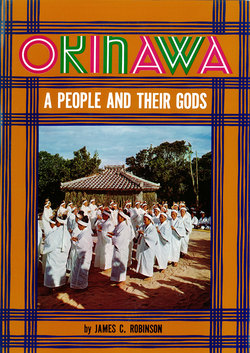Читать книгу Okinawa: A People and Their Gods - Robinson - Страница 11
На сайте Литреса книга снята с продажи.
ОглавлениеChapter 2
NATIONAL
RELIGIOUS HERITAGE
CREATION OF OKINAWA
In traditional Okinawan thought, the creation of Okinawa Shima is synonymous with the creation of the world. Three sources contain the stories of this mythological genesis. The oldest, Omoro Soshi, is an anthology of ancient verses; it contains songs which were collected from a.d. 1531 to 1623 and relates information on the historical, religious, political, economic and cultural affairs of Okinawa. A second document, Ryukyu Shindo-ki, was written by a Japanese monk, Taichu Shonin, and published in 1638. Chuzan Seikan, a third source, was compiled in 1950 by an Okinawan statesman, Haneji Tomohide; it is a more elaborated version than the Ryukyu Shindo-ki.
According to Taichu a pair of sibling-deities, Shinerikyu (a male) and Amaikyu (a female), were directed by a higher kami to create the first land and the first people; this beginning in time is known as the "age of heaven" or "kami time," and these first people as "heaven people." Out of obedience to the higher kami, the two deities descended from heaven and created Kudaka shima. Without benefit of sexual intercourse three offspring were created: a first son (the first ruler), a daughter (the first priestess), and a second son (the first farmer). Some authorities1 are convinced that in the mythological creation story of the first people there is an account of the basic institutions of ancient Okinawan life: political rule, agricultural life, and female religious authority.
In the second account, Chuzan Seikan, both deities descended from heaven and "carried stones and earth to the edge of the sea and planted trees to keep back the waves." After many generations a grandchild, Tenteishi, was born. Tenteishi divided mankind into five classes. His first son became the first ruler; the second son the first noble; the third son the first farmer. The first daughter became the first high priestess and the second daughter the first village priestess. According to mythology the Tenteishi dynasty lasted twenty-five generations, ending in A.D. 1187.
Following the creation of Kudaka Shima (the Okinawan "Garden of Eden") these first people are purported to have crossed the water and settled in the area of Seefa Utaki. Seefa Utaki sits on a high ridge in the Chinen district, overlooking Kudaka Shima. With the development of a water shortage, the people moved about one mile along the coast to the site of the present village of Hyakuna, and from this village eventually ventured forth to populate the island. It is said that in the immediate area of Hyakuna the first rice was planted in a field called, "miifudaa." This field and two nearby springs, "Ukinju" and "Hainju", became important sites for religious pilgrimages.
As a site of worship, Seefa Utaki has traditionally been considered a kind of Okinawa Jamestown, linking the present Okinawan to his ancestral heritage; it is also the prototype for local Community Utaki (sacred groves) all over the island.
SISTER KAMI
Prior to 1429 Okinawa was divided into many principalities, each headed by a hereditary chief or lord (aji/anji). Each aji was assisted by a sibling priestess (chimi) who sustained his position and power by exerting an influence with the spirits that he, a male, did not have. This arrangement has been associated with the oral tradition of the two creator sibling deities. One authority2 reports that the widespread belief throughout the island that the spirit of the sister, living or dead, has both the power to protect her brother from evil and the power to curse him. He reports instances of old men who as boys were instructed by parents not to misbehave toward their sisters lest her spirit bring misfortune to them. Girls, on the other hand, were counselled to maintain friendly relations with their brothers on whom they must rely as adults.
Belief in the spiritual predominance of the sister is not held uniformly throughout Okinawa. It is reported3 that a folk song on the Miyako main island tells of a sister giving a textile to her departing brother; but the people are reported as not knowing what the song implies.
On the other hand, some writers4 strongly believe that this concept of sister kami has served as the origin of the noro/nuru as a force in Okinawan religious life. This conviction is based upon the logic that if a man, as head of a household, would rely upon his sister's kami, how much more likely would a village chief or lord, for his responsibility was even greater. The direct relation of the concept of sister kami to the noro is not accepted by all students of Okinawa.
